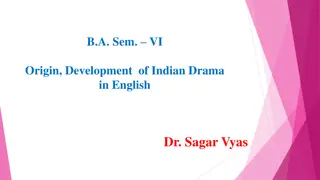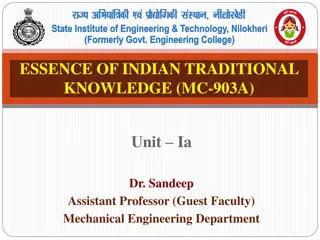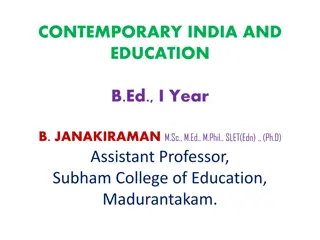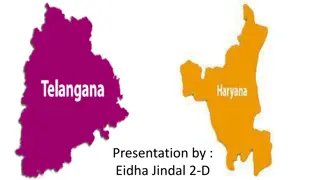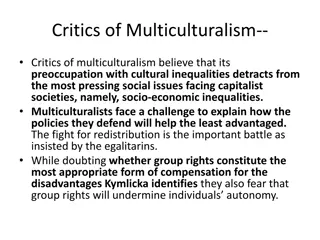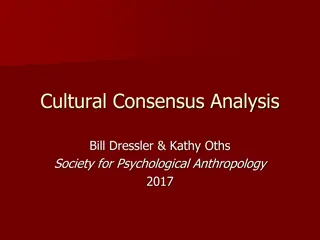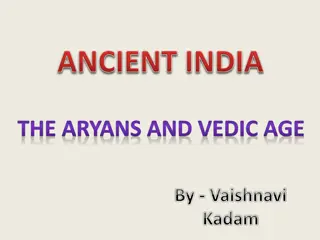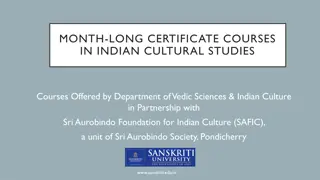Cultural History of India: Early Vedic Period and Aryans
The period of the Aryans in ancient India marked a transition from the Indus Valley Civilization to the Vedic Civilization. The Aryans, possibly migrants from various regions, integrated with the indigenous Dravidians to form the Vedic society. Their culture, as depicted in the Vedas and epics like the Ramayana and Mahabharata, revolved around cattle rearing, agriculture, and tribal organization. The Early Vedic Period saw the development of small kingdoms and trades, shaping the foundation of Indian history.
Download Presentation

Please find below an Image/Link to download the presentation.
The content on the website is provided AS IS for your information and personal use only. It may not be sold, licensed, or shared on other websites without obtaining consent from the author. Download presentation by click this link. If you encounter any issues during the download, it is possible that the publisher has removed the file from their server.
E N D
Presentation Transcript
Cultural History of India until the Mughal Period (BOS19) BDO, SEMESTER I
Unit II Early Vedic and non-Vedic cultures: the proto-types of Caste
ARYANS AND THE VEDIC AGE (1700 BC 500 BC) The Vedic Civilization succeeded the Indus Valley Civilization in ancient India, but there is conflicting historical evidence about its origins. One theory points to the migration of Indo-European tribes, possibly from Central Asia, Iran, Scandinavia or Russia, into northern India in 2000 BC. These nomadic tribals, known as Aryans, mingled with the Dravidians from the Indus Valley and eventually established what came to be known as the Vedic Civilization. It was spread across the Sapta Sindhu (Seven Rivers) region, in the present- day Indian states of Haryana and Punjab.
The ancient Hindu scriptures, the Vedas, dated between 1500 BC and 800 BC, provide extensive details of the Vedic Civilization: The Rig-Veda, the earliest document of Indian history, gives a comprehensive account of life in the early days of the Aryan society, while later works such as the Sama-Veda, Yajur-Veda and Atharva-Veda provide details about the subsequent years. The Vedas were composed in the Sanskrit language, and the Vedic Civilization takes its name from these ancient scriptures. The great Indian epics, the Ramayana and the Mahabharata, are also believed to have originated during this period of Indian history. The Vedic age is divided into the Early Vedic Period (1700 BC 1000 BC) and the Later Vedic Period (1000 BC 500 BC).
Early Vedic Period (1700 BC1000 BC) The Aryans were tall and fair in appearance. They organized their community into small tribal units called jana, with chiefs (sabha) and ruling councils (samiti). The jana was further divided into smaller segments called vish and grama. There were several janas, and they fought amongst each other for cattle and land. The janas developed into janapadas, small kingdoms with a supreme chief, the raja or king, who commanded the army. The king was assisted by the senani (army chief) and the purohita (chaplain), who took on the role of a medicine man, curing diseases with the use of incantation. The Aryans had a primitive nomadic culture and did not have knowledge of sophisticated urban planning as seen in the Indus period. Rather, their houses were simple structures built of mud.
However, like the Indus people, the Aryans were skilled in making bronze utensils and weapons. Their main occupation was cattle rearing and agriculture. Cattle were highly valued and used as a medium of exchange in the barter system. The people also bred sheep, goats and horses, using the latter for their war chariots. Spinning, weaving and carpentry were other common trades.
Aryans Introduce the Caste System The Aryans had a patriarchal society, with the father regarded as the head of the family and the mother occupying an inferior position. Monogamy was widely practiced, and sons were coveted because the family heritage passed from father to son. It was during the Vedic period that India s infamous caste system (varna) was born. Society was divided into separate classes based on occupation: the priests, known as Brahmins, were the dominant class and wielded the most power ; the ruling and fighting classes were called Kshatriyas; traders and merchants were classified as Vaishyas and the laborers were known as the Shudras. Social distinctions became increasingly rigid and the classes developed into hereditary castes, with restrictions placed on intermarriage. The religious consciousness of the Aryans was highly developed, although they did not pray at temples or worship images. Their rituals consisted of burning fires at home, singing hymns to the gods, making offerings such as rice and milk and sacrificing animals. The Aryan gods included Varuna (Thunder), Surya (Sun), Agni (Fire), Vayu (Wind) and Usha (Dawn).
Brahma and the Caste System According to popular belief, the four varnas were created from different parts of Brahma, the creator. The Brahmins were created from his mouth, the Kshatriyas from his hands, the Vaishyas from his thighs and the Shudras from his feet. LAWS OF MANU The Brahmins, the most learned sect, laid down rules and regulations, customs, laws and rites for the rest of society in manuals called the Dharma- shastras. Of these the most ancient and most famous is the Manava Dharma-shastra (Laws of Manu), belonging to the ancient Manava Vedic school. The Laws of Manu comprises of 2,684 verses and deals with the norms of domestic, social and religious life in India.
LATER VEDIC PERIOD (1000 BC500 BC) In the Later Vedic Civilization, agriculture became the main economic activity of the people while cattle rearing declined. Popular crafts developed into vocations and goldsmiths, ironsmiths and carpenters came to the fore; iron, especially, became a commonly used metal during this period. Another change was the merging of the numerous small kingdoms or janapadas to create 16 large ones known as the mahajanapadas or great kingdoms. This period also saw progress in political and economic organization, with a tight-knit monarchy replacing the earlier tribal rule. Power moved from the rural to the urban centers where noblemen usurped positions of authority. Strides were made in religious thought too, with ideas from a new Hindu culture taking root. The Aryans used the Vedic Sanskrit language up to the 6th century BC, when their culture gradually began to shift to Brahmanism, an early form of Hinduism. This marked the end of the Vedic Civilization.







